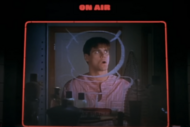Create a free profile to get unlimited access to exclusive videos, sweepstakes, and more!
Manufactured love? The science behind romantic comedies
Today, on the loveliest or loneliest day of the year, we’re wondering if it’s really possible to fall in love with just anyone.

For some, Valentine’s Day is the most romantic day of the year. While personal anniversaries provide an opportunity for intimate celebrations of love, Valentine’s is the only day set aside to publicly demonstrate the love you have for the special person or people in your life. For others, the 14th of February is a painful reminder of love lost and the promise of a lonely evening eating heart-shaped candy alone in the dark. Whether you’re spending the night by yourself on the couch or looking for something to watch after dinner with your paramour, there’s plenty to choose from in the “Love Is in the Air” section of the Peacock hub.
One thing we’ve noticed while perusing the romantic streaming offerings and appreciating the unique way that the salt in tears really brings these dollar store chocolates to life, is that so many rom coms involve two people being thrust into an unlikely romance. Against all odds, by the time the credits roll they inevitably discover that they actually do love one another and live, presumably, happily ever after.
RELATED: Make Valentine’s Day weird with these 6 unconventional sci-fi love stories
According to the movies, almost anyone can be soul mates, so long as they experience the right set of circumstances together. In a way, it makes a sort of sense. Our entire lives, including our love lives, are just a set of circumstances falling in just the right (or just the wrong) way. So, today, on the loveliest or loneliest day of the year, we’re wondering if it’s really possible to fall in love with just anyone.
INGREDIENTS FOR LOVE
Take Judd Apatow’s Knocked Up (one of the many fine amorous offerings streaming on Peacock), for example. Ben (Seth Rogen) and Alison (Katherine Heigl) would likely have never spoken in the light of day. But the unique alchemy of the night club has other plans. When a night out results in an unplanned pregnancy, two unlikely people discover a love they wouldn’t otherwise have even considered. As Steven Arthur Stills (of Crosby, Stills & Nash fame) once said, “if you can’t be with the one you love, love the one you’re with.” While this certainly doesn’t apply in every situation — some relationships, perhaps even most, should probably end for the happiness and safety of everyone involved — there does appear to be some evidence that love is something manufactured together by the members of a relationship.
Figuring out how that happens requires jumping into the complex soup of chemicals roiling around inside your brain. It’s worth noting that not everyone experiences love or attraction in the same way and some or all of the following may not apply in your specific circumstance. These are the broad strokes science has been able to determine that appear to be true most of the time. That said, according to a team of Rutgers researchers, romantic love is typically comprised of three components: lust, attraction, and attachment, each of which have a set of associated hormones.
Lust and attraction might sound like the same thing, but scientists note they are controlled by different parts of the brain and can happen independently of one another. While lust relates to sexual pleasure and is driven by testosterone and estrogen, attraction relates to the brain’s reward system and is controlled by things like dopamine and serotonin. You can gain pleasure simply from being in a person’s presence even if there’s no physical desire, and that appears to be one of the central ingredients of romantic love.
The last ingredient, attachment, is facilitated by hormones like oxytocin (often referred to as the love hormone) and vasopressin. These are also a component of other close relationships, like those with close friends, children, and even pets. The fact that these processes are controlled by different hormones and different parts of the brain probably isn’t a mistake. It allows us to have a diverse set of relationships and experience different types of love with our friends, with our family, and with our romantic partners.
TAKING OVER FOR THE FATES
The question then becomes if you can intentionally generate those feelings. Can people make a conscious decision to embark upon a relationship with intention in a way which pushes the right brain buttons and cooks up the right chemical soup to create a romance?
That’s more or less what a husband and wife team of psychologists have dedicated their lives to finding out. In 1997, Arthur and Elaine Aron, and a few colleagues, published a paper titled “The Experimental Generation of Interpersonal Closeness: A Procedure and Some Preliminary Findings” in the Personality and Social Psychology Bulletin.
RELATED: Taming lions with a chemical love potion
The study describes an experiment in which strangers are paired off and given a period of 90 minutes to ask one another a series of 36 questions. The questions start off simply enough with things like who you’d most like to have dinner with, or if you want to be famous and why. As the questions progress, they slowly become more intimate, requiring both the asker and the answerer to be more vulnerable with themselves and with one another. Eventually, you’re asked to recount your life story in four minutes, whether you’d want to know your future, your dreams, your values, and your worst memory. And that’s before things move into overdrive.
The last section of questions moves into intimate territory. Participants are asked to complete the sentence: “I wish I had someone with whom I could share…,” which family member’s death they’d be most disturbed by, and twice to state things that you like about the person you’re paired with. Finally, participants are asked to stare into one another’s eyes for four unbroken minutes.
The idea behind the questions is to slowly turn up the heat and create a space in which both people allow themselves to be truly vulnerable. It creates a situation of intimacy in which both parties have to trust themselves and their partner. And the experiment shows that those situations can push the right buttons and create a space for lust, attraction, and attachment to thrive. In essence, it appears to boil down the sort of closeness which usually arises after weeks or months with a partner into an hour and a half. Two of the participants in the original study, both strangers when they started, were married six months later and that isn’t the only success story involving the questions. Mandy Catron relates her own story of recreating the experiment in a piece published by the New York Times.
RELATED: 14 sci-fi movie and TV couples we can’t help but stan for Valentine’s Day
Whether you can fall in love with absolutely anyone remains to be seen and probably won’t be answered in a lab, but it seems clear that if you’ve decided to be with someone there are ways to intentionally strengthen your relationship by exploiting your brain’s cheat codes.
If you’re looking for stories of love gone right (or wrong), Peacock's collection of romantic comedies is sure to have what you’re looking for.




























